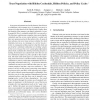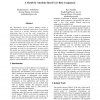151 search results - page 10 / 31 » Using trust and risk in role-based access control policies |
CSIE
2009
IEEE
15 years 6 months ago
2009
IEEE
While mobile handheld devices, such as cell phones and PDAs, provide productivity benefits, they also pose new risks. A vital safeguard against unauthorized access to a device’s...
NDSS
2006
IEEE
15 years 5 months ago
2006
IEEE
In an open environment such as the Internet, the decision to collaborate with a stranger (e.g., by granting access to a resource) is often based on the characteristics (rather tha...
108
click to vote
SDMW
2004
Springer
15 years 5 months ago
2004
Springer
Abstract. Researchers have recently begun to develop and investigate policy languages to describe trust and security requirements on the Semantic Web. Such policies will be one com...
ESORICS
2009
Springer
16 years 7 days ago
2009
Springer
Abstract. Recent years have seen unprecedented growth in the popularity of social network systems, with Facebook being an archetypical example. The access control paradigm behind t...
107
click to vote
ACSAC
2002
IEEE
15 years 4 months ago
2002
IEEE
The Role-Based Access Control (RBAC) model is traditionally used to manually assign users to appropriate roles, based on a specific enterprise policy, thereby authorizing them to ...



